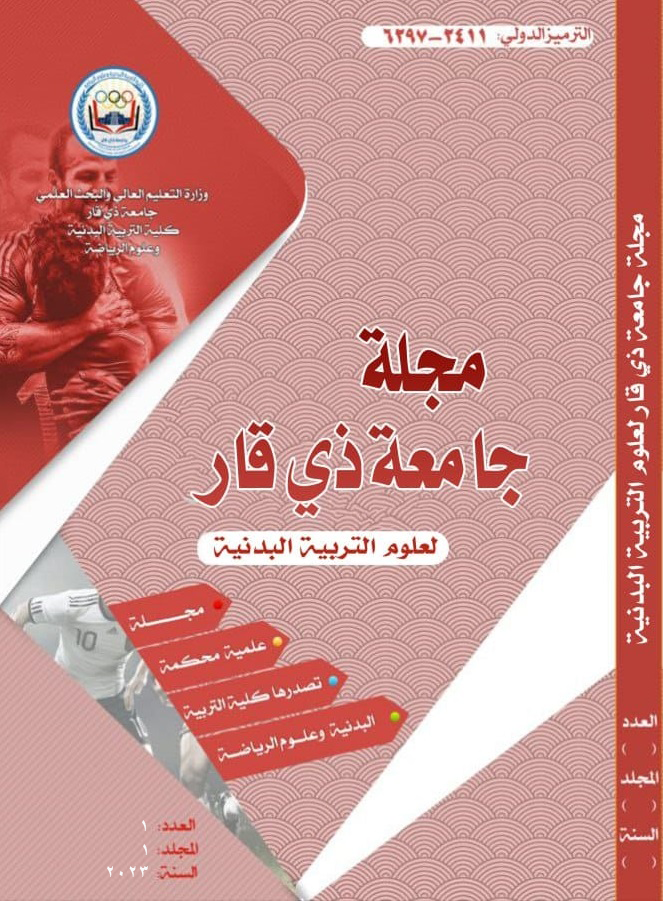أثر أنموذج Woods بمصاحبة تمرينات مهارية عقلية في تعلم دقة مهارة التمرير بكرة القدم لطالبات.
DOI:
https://doi.org/10.32792/utjspe.v1i4%20الجزء%20الأول.227Abstract
The research problem was crystallized. Despite the extreme importance of learning football skills, including the skill of passing, in an effective and integrated manner, the traditional methods of learning seemed to lack focus on learning the applied aspects of basic football skills, including the skill, in the light of research, in a way that contributes to accelerating the learning process, as it seemed to be given in a separate manner. Whether without subjecting the educational units to doses of educational models and putting them towards the learners, while supplementing those units with purposeful exercises of a skillful and mental nature that accelerate the learning process, and from here the researcher, being a specialist in the field of teaching methods, believes that the need has become urgent to use teaching models with the integration of these models. Modern ones, such as the Woods model, combine skill and mental exercises to create a combination capable of steadily raising the level of learning, since the target group is female students who may lack previous experience with football topics if their experiences are compared with male students, and thus when the model is mixed with those exercises. The objectives of the research were: preparing educational units according to the Woods model in learning the skill of passing with mental skill exercises in soccer for female students, preparing mental skill exercises in learning the skill of passing in soccer for female students, identifying the effect of the Woods model accompanied by mental skill exercises and the method followed by the teacher in learning the skill. Passing with a soccer ball for female students, and identifying the differences between the results of the post-tests between the control and experimental groups in learning the skill of passing with a soccer ball for female students. While the researcher assumed: There are statistically significant differences between the results of the pre- and post-tests for the control and experimental groups and in favor of the post-tests in learning the accuracy of the passing skill. There are statistically significant differences between the results of the post-tests of the control and experimental groups, in favor of the experimental group in learning the accuracy of the passing skill. The researcher used the experimental method by designing two equal experimental groups. Because this design achieves the objectives and hypotheses of the research, the research population was determined by female students (first level) in the College of Physical Education and Sports Sciences / University of Thi Qar. The researcher chose this study stage because it is compatible with the nature of the problem that emerged. Including the research project. The basic skills in football, including the skill of passing, are taught at the level (first stage) within the football curriculum. The number of them is (81) female students for the academic year 2023-2024, distributed into the two divisions (A, B). After the homogeneity procedure for female students, (11) female students were excluded. They are some absent, injured students, and some students with morphological variables that may be affected by the results of the study. As for the research sample, the researcher chooses it in different ways, as the researcher used the random method using a lottery method, and the choice fell on Division (A) as an experimental group that receives learning the skill of passing according to the Woods model, accompanied by skill exercises. The mentality of a sample consisting of (40) female students, and Section (B) was chosen as a control group. A sample consisting of (30) who receives learning according to the curriculum taught to teach basic skills in football, including the skill of passing, noting that the percentage of the sample from the community of origin amounted to (49.38%). The research experience was based in its steps on the Woods model, accompanied by mental skill exercises that were used in the research. Tests were determined for the chosen skill in light of the research. It also included exploratory experimentation, the scientific foundations of the tests, and pre- and post-tests. Then the outputs were grouped through the use of statistical methods that are compatible with the problem and objectives of the research. The results were then presented, analyzed, and discussed in a scientific discussion based on scientific sources. The researcher reached some conclusions, the most important of which was that the Woods model contributed to improving the learning of the passing skill among female students. Likewise, integrating teaching models in the upper stages with exercises of a skillful and mental nature creates a state of cognitive balance. The students’ behavioral behavior was clearly in the interest of learning the skill of passing.
Downloads
Published
Issue
Section
License
Copyright (c) 2024 م.د علي جاسم سوادي

This work is licensed under a Creative Commons Attribution 4.0 International License.









